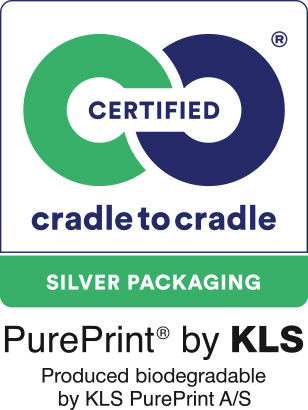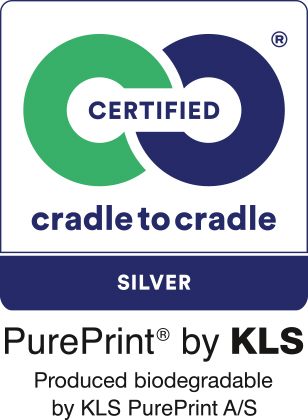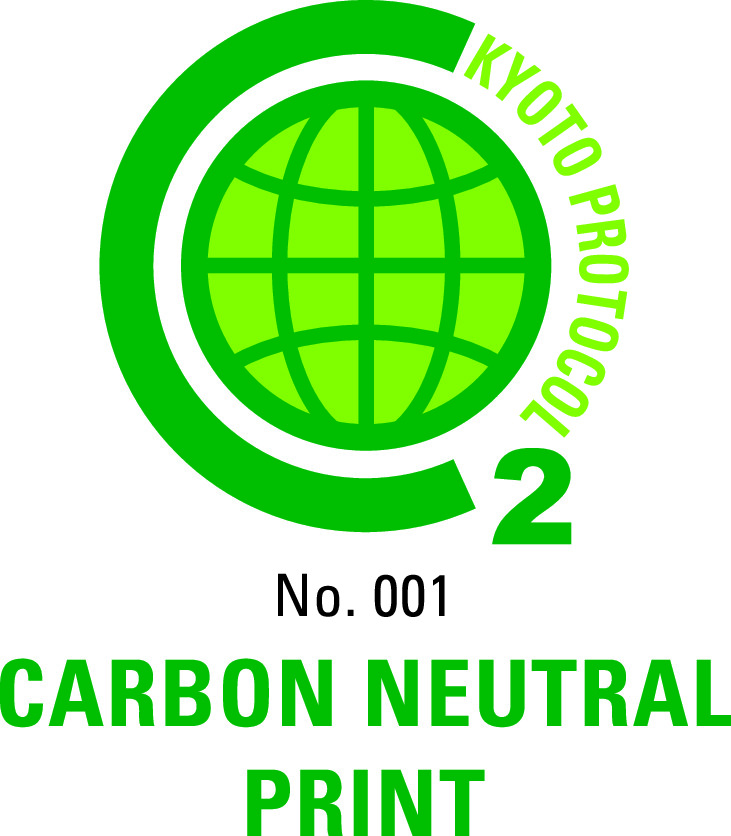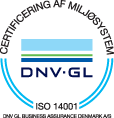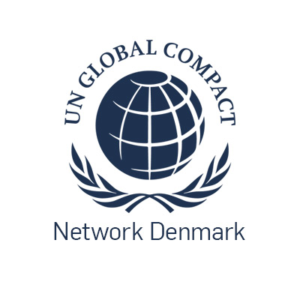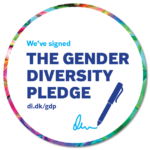PUREPRINT
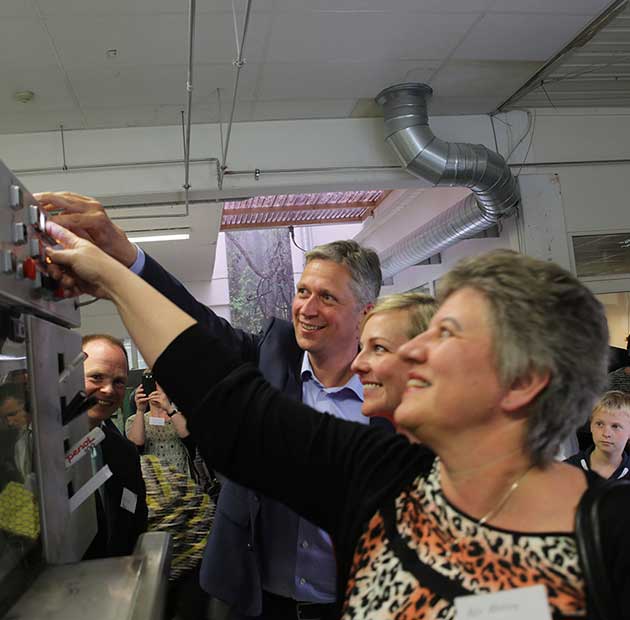
FULL SUSTAINABILITY
With PurePrint you get products that are Cradle to Cradle Silver certified and produced CO2 neutral (carbon offset – see here).
In order for a PurePrint print item or packaging to be certified at min. bronze level, we have had to map all ingredients in order to obtain documentation that no chemicals or heavy metals from the “Banned list of Chemicals” are added anywhere in the production process or that CMR substances are found in the product. The goal is that only substances are used that can enter healthy circulation without harming people and the environment. We recommend using the products for recycling, which makes the best use of the earth’s resources, but the products are also biodegradable. We call that more sustainable, and that was the goal of our major development project.
A HUGE DEVELOPMENT PROJECT
The development of PurePrint took more than three years and cost several million danish kronor. Fortunately, the project attracted significant attention. The Danish Business Authority, its Fund for Green Business Development and the Capital Region made development funds available for the groundbreaking project.
NEW INKS, CONSUMABLES AND PAPER
The goal was to offer a product whose quality was matching traditional products and prices. But without any chemicals causing negative consequences or hazardous on either people or nature when produced, used or disposed of. We therefore had to develop all new inks, paper and consumables without any harmful components.
SUCCES WAS ACHIEVED IN MAY 2015
In May 2015, KLS PurePrint produced the first PurePrint item – a 100% biodegradable poster. The poster was a Carsberg promotional item featuring the famous Carlsberg elephant. Former environment minister Ida Auken, CEO of Carlsberg Denmark Carsten Hänel and Municipality of Hvidovre Mayor Helle Adelborg pushed the button.
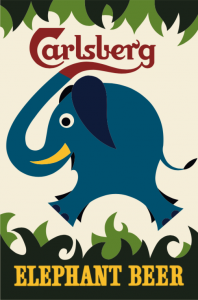
CRADLE TO CRADLE
ECO FRIENDLY PRODUCTS FROM START TO FINISH
KLS PurePrint has been Cradle to Cradle certified since 2015. This environmental certification guarantees that a product does not pollute, does not consume the Earth’s resources and becomes part of the natural cycles after use. The idea is to invent and produce the products, so it can be used over and over again. As a result, the products do not generate any waste and they are not toxic to humans or the environment. This is called “circular economy”.
MORE THAN A PRODUCT BRAND
Cradle to Cradle is not a product brand, but rather a certification that takes the entire life cycle of the product into account. The entire organisation must live up to the strict requirements for sustainability in five areas in order to become certified.
Non-toxic materials
The organisation commits to using only substances capable of being part of natural cycles and having no harmful effect on human beings or the environment.
Recycling of materials
The product must be able to be part of biological or technical cycles so that it does not generate waste.
Renewable energy and carbon management
The organisation must be carbon neutral and must use 100% renewable energy in all processes.
Protection of water resources
Process waste water must be sufficiently purified so that it in principle is potable.
Social responsibility
The organisation must demonstrate social responsibility based on recognised standards – for example, the Global Compact initiative.
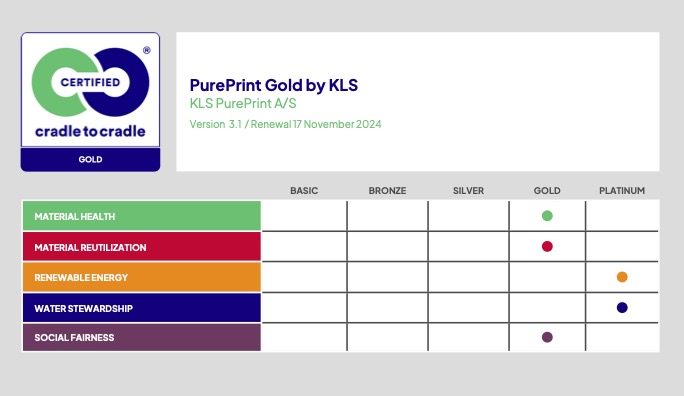
The Cradle to Cradle certification requires continuous improvement of both product and processes. The rating scale has 5 levels – BASIC, BRONZE, SILVER, GOLD and PLATINUM. In all 5 areas, you must have a roadmap that describes how to reach the ultimate PLATINUM level. Every two years, the development is reviewed and approved by the certifying authority.
For each category, the product is assigned points that tell you how far you have come in the area in question. The overall certification level is determined according to the lowest level achieved in any of the five categories. At the certification in 2015, KLS PurePrint was registered at the BRONZE level, but already in 2016 the level was raised to SILVER. This is because they succeeded in phasing out CMR substances, which are suspected of being endocrine disruptors and cancer-causing. We have been working hard to become certified at the GOLD level and in January 2023 we became certified at the GOLD level for our Folding Box Board.
CRADLE TO CRADLE Q&A
We are often asked questions about the Cradle to Cradle standard. We have put together a selection of these together with answers so that you can get to know Cradle to Cradle Certified™ a bit better. If you would like to receive detailed answers or source references, please let us know. We will also be happy to come to you and give you a presentation and demonstrate samples of sustainable printed matters and packaging. If there are any other questions that you would like to know the answer to, do not hesitate to send an email to beh@kls.dk, and we will get back to you promptly.
What is Cradle to Cradle Certified™?
Cradle to Cradle Certified™ is an independent international ecolabel. Also refer to the description of the label in Mærk din forretning [Certify Your Business], a book by, among other things, Jakob Zeuthen, Environmental Policy Director at the Danish Chamber of Commerce. It says:
“The international Cradle to Cradle Certified™ Product Standard is a design concept, where products are part of biological or technical cycles, creating value for people, the environment and the economy. The standard is administered by an independent organisation, the Cradle to Cradle Products Innovation Institute.”
It also mentions that one of the strong points of the label is its recognition by B-Corp, LEED, BREEAM and DGNB, which contributes to its international visibility. The organisation is described as inclusive and transparent.
Who is behind Cradle to Cradle?
As early as in the 1990s, the principles of a cradle to cradle approach – Cradle to Cradle – began to be discussed. The concept got its big break in 2002, when American architect William McDonough and German chemist Michael Braungart published the book: “Cradle to Cradle: Remaking the Way We Make Things”, translated into Danish as: “Cradle to Cradle – Rigdom og vækst uden affald”. The book remains available for purchase and is highly recommended
Is Cradle to Cradle a private American label?
No, certainly not. The owner of the certification scheme, the Cradle to Cradle Products Innovation Institute, is an independent non-profit organisation. It operates internationally from offices located in the USA and the Netherlands.
Why did KLS PurePrint opt for Cradle to Cradle Certified™?
In our work to become the greenest printing house in the world, we sought out the world’s ecolabel that, in our opinion, set the toughest requirements and best documented our work to close the loop and create a circular, waste-free business model. We also wanted to work towards zero tolerance for hazardous chemicals. In our opinion, the label that met our objectives the best was the international Cradle to Cradle Certified™ ecolabel. Moreover, Cradle to Cradle also places requirements for continual improvement. The objective is to make sure that a product only contains materials that are healthy for both humans and the environment. Therefore, the choice fell on Cradle to Cradle Certified™.
Is it only the product that is Cradle to Cradle certified?
No, Cradle to Cradle Certified™ is holistic/comprehensive label that, in addition to taking into account a product’s properties, also takes into account all other aspects of production, subcontractors, impact on society, CSR, etc. Manufacturers are certified in five specific areas, as follows:
- Material health
- Material reutilisation
- Use of renewable energy and CO2 management
- Water resources management
- Corporate social responsibility
Cradle to Cradle further works five levels of certification, from Basic, through Bronze, Silver, Gold and ultimately to Platinum. KLS PurePrint is currently at Silver level. For further information, see www.vuggetilvugge.dk
Certain more specific measures include KLS PurePrint’s use of FSC-certified European timber, where felling is always accompanied by replanting, the use of renewable wind energy only and the operation of electric cars only. We have been carbon-neutral (carbon offset — see here) since 2009.
Is it permitted to use hazardous chemicals and heavy metals in the production of a Cradle to Cradle certified printed matter or packaging?
The certification of any PurePrint product requires the mapping of all of its constituent substances and the issue of documentation that the product does not contain any CMR substances and that no stage of its production process employs chemicals or heavy metals from the “Banned list of Chemicals”. The objective is to exclusively use substances that can be included in the cycles of nature without harming either people or the environment. The principle requires full identification of everything incorporated into the product. All of the product’s constituent substances have to be identified. The initial stage is to ensure that the product complies with the “Banned List of Chemicals”. This is a basic requirement where compliance is only required at the lowest level, Basic, which is a two-year learning level that does not give the right to label the product with the Cradle to Cradle logo. From Bronze level, all content that stands for 1/10,000 of the weight of the product (0.01% or 100 ppm) or more is declared and assessed based on a strict set of criteria.
Products often contain ingredients from typically 4-5 subcontractors or, to put it in another way, we go all the way back to the supplier of the supplier of the supplier of the supplier of our own supplier to obtain knowledge about all chemicals. KLS PurePrint is Cradle to Cradle Silver certified.
Is Cradle to Cradle Certified™ committed to the recycling of printed matters and packaging?
Yes, this is one of the fundamental principles of the circular economy. A Cradle to Cradle certification demands that recycling take place at the highest value level possible. In Denmark, this means that paper and board need to be recycled as many times as possible. Denmark has a well-organised return system that guarantees that natural wood fibres are reused five to eight times before being incinerated. Fibre recycling requires the cleaning and pre-processing of fibres prior to reuse, a process that needs chemicals and energy for heating. At present, 50 – 55 per cent of fibres in Denmark are recycled. The rest is incinerated directly or is otherwise lost. Once fibres have been in contact with food, their recycling is not permitted, as they either end up dissolving or pose a risk of bacterial contamination. KLS PurePrint always recommends recycling, as this is what exerts the lowest environmental impact.
Is it important for printed matters and packaging to be biodegradable?
It is not permitted to recycle food contact materials. In this situation, biodegradability is therefore the primary intended scenario. Biodegradability also provides a good guarantee that materials that are not recycled for one reason or another will not introduce any harmful chemicals and heavy metals into the environment. Cradle to Cradle demands that products be recycled in the most expedient manner. However, only up to 55 per cent of fibres are currently recycled, which is why it is also relevant to see to the environmentally sustainable processing of the rest.
Is KLS PurePrint only Cradle to Cradle certified?
No, KLS PurePrint was one of the first printing houses in Denmark to be awarded the Nordic Swan Ecolabel back in the 1990s. We have since become FSC certified, Carbon Neutral certified, ISO 14001 certified, pledged commitment to the UN’s Global Compact, all of which was then followed by the Cradle to Cradle certification. We continually work with different types of documentation to ensure that our sustainability profile is well-documented and supported by external evaluations and certifications. Ecolabels are not an end in themselves but are rather necessary documentation for KLS PurePrint’s environmental work
Are there any other Cradle to Cradle certified Danish companies?
Yes, there are currently a good many Danish companies holding Cradle to Cradle certifications, among other things, Egetæpper, Troldtekt, Dansign, Gabriel boligtekstiler, Kalk, KE Fibertec, Rheinzink, Derbigum and Dansk Wilton.
Are there any examples of foreign Cradle to Cradle companies and how widespread is the label?
An ever increasing number of foreign companies are working according to Cradle to Cradle principles. Several major brands are on the list of Cradle to Cradle certified products. L’Oreal has launched a Garnier skincare line, G Star markets “The most sustainable jeans ever”, Wolford launched a lingerie and sock line in July 2018, and C&A are now selling ”compostable T-shirts”. There are more than 600 active Cradle to Cradle Certified™ certificates globally, covering some 10,000 certified products.
Read detailed note on Cradle to Cradle.
Where can I read more about Cradle to Cradle?
Read more on the website of the Cradle to Cradle Products Innovation Institute: https://www.c2ccertified.org/
More information in Danish is also available at https://vuggetilvugge.dk. Vugge til Vugge ApS is the only Cradle to Cradle Certified™ Accredited Assessment Body in Denmark.
CO2-NEUTRAL PRINTING
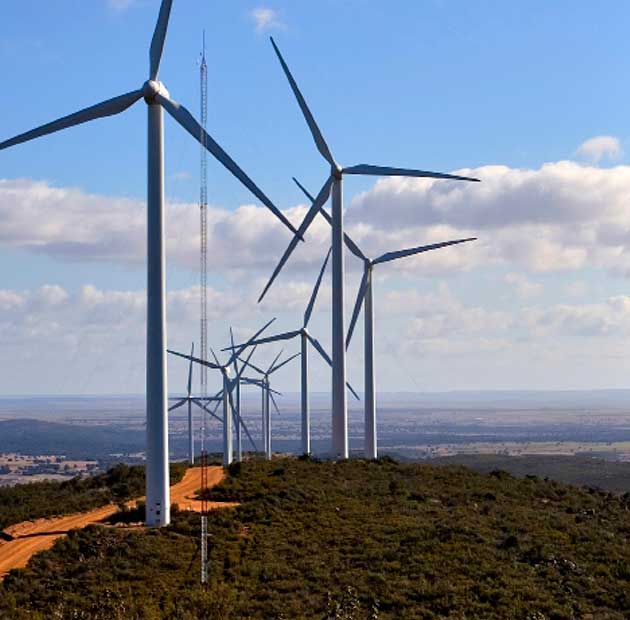
SCANDINAVIA’S FIRST CO2-NEUTRAL PRINTING HOUSE
KLS PurePrint has worked resolutely to be CO2neutral since 2006. Every single aspect of the company’s production methods and energy consumption has been analysed and mapped. Wherever improvements and optimisation were feasible, they were implemented. As early as 2009, KLS PurePrint succeeded in being the first printing house in Scandinavia to go CO2neutral.
AN ONGOING PROCESS
The company has continued to work on reducing emissions ever since. In 2010, KLS PurePrint invested in Denmark’s first electric truck and today all electricity comes from our own windmill. All company cars purchased since 2012 are electric cars. In six-years KLS PurePrint has cut expenses for heating in half and reduced electricity consumption by 38% per unit produced. As an additional environmental investment, the company has installed a climate friendly white roof that reflects solar heat and therefore reduces global warming.

REQUIREMENT FOR EMISSIONS TRADING (CAP AND TRADE)
It is not possible to achieve production and transportation completely without CO2 emissions. That’s where emissions trading comes in. Each year, KLS PurePrint calculates the residual CO2 emissions and then compensates for them by purchasing CER (Certified Emission Reduction) permits approved by the United Nations for CDM (Clean Development Mechanism) projects. CDM projects guarantee lower CO2 emissions in developing countries. Examples of sustainable CDM projects we have supported: A project in India, where wind turbines have enabled the shutdown of a coal power plant and a project in Argentina, where methane gas is collected from a landfill.
Specifically, our permits are currently applied towards the replanting and restoration of degraded mangrove forests in Myanmar. See more here. (<– link)
COMPOSTABLE PACKAGING
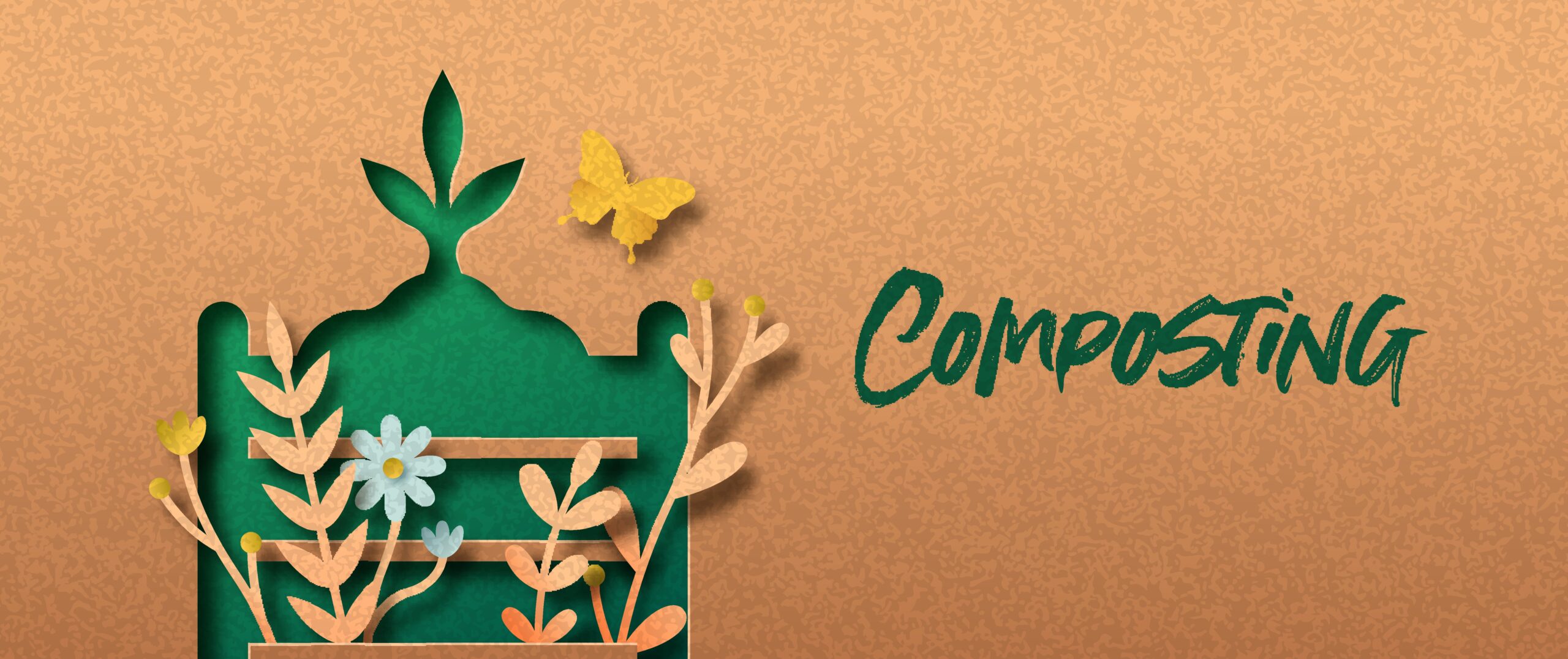
COMPOSTABLE PACKAGING
At KLS PurePrint, we want to make our products as sustainable as humanly possible. Therefore, we are working hard to contribute to the transition to circular economy, where products are reused and materials are recycled to the highest extent possible. This is one of the reasons for becoming Cradle to Cradle certified.
However, if it is impossible to recycle certain paper and board, among other things, because of contact with food, it is important to ensure that the product is compostable and nutrients can be reused. Therefore, we have worked persistently for a number of years to have our products approved in accordance with European Composting Standard EN 13432 and have been successful with this.
The standard scrutinises products for their content of a number of chemical substances and heavy metals as well as for their biodegradability, desintegrability and compostability. The PurePrint products fulfilled all requirements and ended up being fully composted after 12 weeks (at 28 degrees), while the requirement permitted max. 26 weeks. Thus, the PurePrint packaging lives up to both industrial composting requirements and the stricter requirements for lower temperatures that correspond to home composting requirements.
The products also comply with American standard ASTM D6868 and with ISO 18606. Moreover, the products also meet the requirements in the Statutory Order on Sludge and can therefore be subjected to gasification in Denmark.
The project was carried out with the support and mentoring of the Danish Market Development Fund, which made a commitment on account of the “high news value and immense market potential” of the project.
Do not hesitate to contact us if you need in-depth information or could take an interest in having your products delivered in compostable packaging going forward.
COMPOSTABLE AND BIODEGRADABLE
A product may only be composted if it can break down, under certain conditions and within a certain time period, into carbon dioxide, water and a fraction of its original mass (10%) without leaving toxic residue behind. This decomposition process should exclusively take place using the help of micro-organisms or enzymes. Moreover, it is important to note that biodegradable is not the same as compostable, as it refers to the time that a product takes to degrade. For example, a product that takes 100 years to break down to its basic molecules would be biodegradable, yet it would only be considered compostable if the process can be accelerated to 90 days under the right conditions (source: Eco biopack).
ESG — Environment, Social and Governance

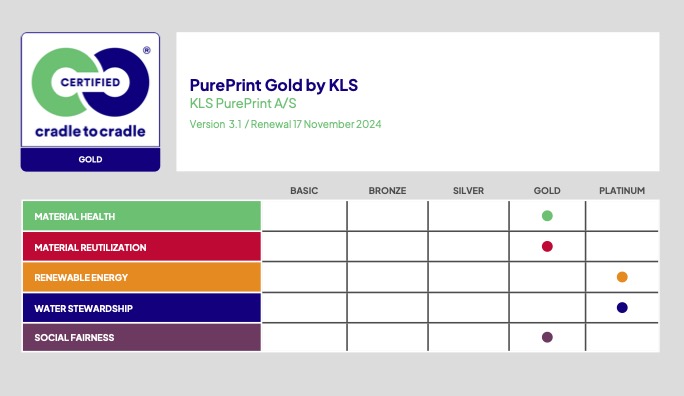
At KLS PurePrint, we have worked for many years to improve the environment through actions as well as to develop printed matters and packaging that are as environmentally sound as humanly possible. The work is an element in our vision of becoming the world’s greenest printing company.
We actively work with the EU’s ESG taxonomy, which covers Environment, Social and Governance, both through our certifications, Cradle to Cradle, FSC and the Nordic Swan Ecolabel and through other initiatives for the benefit of the environment, society and corporate governance.
We work, in particular, with:
Climate protection and climate change adaptation: Securing clean air without any hazardous emissions and preventing climate change through the use of renewable energy is one of the five key points contained in the Cradle to Cradle certification — the third one, to be precise.
Sustainable use of water and marine ecosystems: The fourth key point in Cradle to Cradle stipulates that the production should protect both land and water against pollution and depletion.
Circular economy: Cradle to Cradle is the epitome of circular economy and the entire philosophy underlying the certification, which has led to this point, has also being adopted as the basic concept underpinning our strategy and the environmental work here at KLS PurePrint.
Pollution prevention and control At KLS PurePrint, we map everything our Cradle to Cradle certified materials contain, thereby ensuring that they do not contain any hazardous chemicals, cf. Cradle to Cradle’s “Banned list of Chemicals”. This is how we make sure that our materials do not contribute to pollution.
Regenerative ecosystems and protection of biodiversity and wildlife: The fourth key point in Cradle to Cradle stipulates that the production should protect both land and water against pollution and depletion. The FSC certification also focuses on this key action area as trees in FSC forests are felled at a rate no faster than the forest can rejuvenate itself. At the same time, the FSC is a guarantee that animal and plant life are protected and that forest workers are trained and employed on fair terms. In addition, KLS PurePrint launched a partnership with the Danish Society for Nature Conservation in 2017, the objective of which was to eventually perform a redesign of KLS PurePrint’s green areas in order to promote biodiversity. In 2022, this translated into a major partnership with several companies in the Avedøre Holme and Hvidovre Municipality, with the vision of creating Denmark’s greenest industrial zone, where 6 hectares or 60,000 m2 have been planted with wild flowers and set aside for bees and insects.
Diversity and equality: The fifth key point of the Cradle to Cradle certification relates to social justice, stipulating that manufacturers are supposed to make a contribution to a just society that is free of discrimination.
Human rights, health and safety: Since the point stipulates that manufacturers must respect human rights, the fifth key point in Cradle to Cradle applies here as well. Moreover, KLS PurePrint’s materials are healthy for people and the environment, i.e., they do not contain hazardous chemicals, as stipulated in key point no. 1 Material health. In addition, our strict Nordic Swan Ecolabel certification places strict environmental and chemical requirements, thus helping promote both health and the environment. The Nordic Swan Ecolabel looks at what is referred to as a “life cycle”. In order words, at the entire journey of the product and at any environmental problems that arise along the way — for the benefit of people, the environment and the Earth’s resources KLS PurePrint has been a member of the Global Compact since 2018 and has therefore undertaken to integrate the ten universal principles within the areas of human rights, labour rights, the environment and anti-corruption into our strategy and operations as well as to contribute to the achievement of the UN’s 17 Sustainable Development Goals.
Board diversity and equal pay: Board diversity is important for ensuring that all genders are represented at a high level of governance and are thus able to bring different perspectives into the Board. In addition to the co-owners of KLS, we have two “professional” members on the Board, and we aspire to have one of each gender in these positions. Giving equal pay to men and women is a statutory requirement in Denmark, and we at KLS PurePrint naturally comply with it. In other words, anyone who performs the same or equivalent work gets the same pay, regardless of gender. Equal pay is also a focus area that is incorporated into the Cradle to Cradle certification.
Management structure in the extended value chain: We investigate the extended value chain through FSC, Cradle to Cradle and Global Compact. The certifications help KLS PurePrint ensure that the company’s suppliers live up to the same requirements as those KLS PurePrint is subject to. In addition, we map chemicals in all stages of the chain and safeguard employer rights. As a result of the mapping of materials, all constituent materials that do not live up to the requirements are phased out or replaced. However, this is also an area where we at KLS PurePrint are aware that we can do more and where we continually work, via the Cradle to Cradle certification, to safeguard labour rights as well as safety — also many links down the chain.
ENVIRONMENTAL CERTIFICATIONS
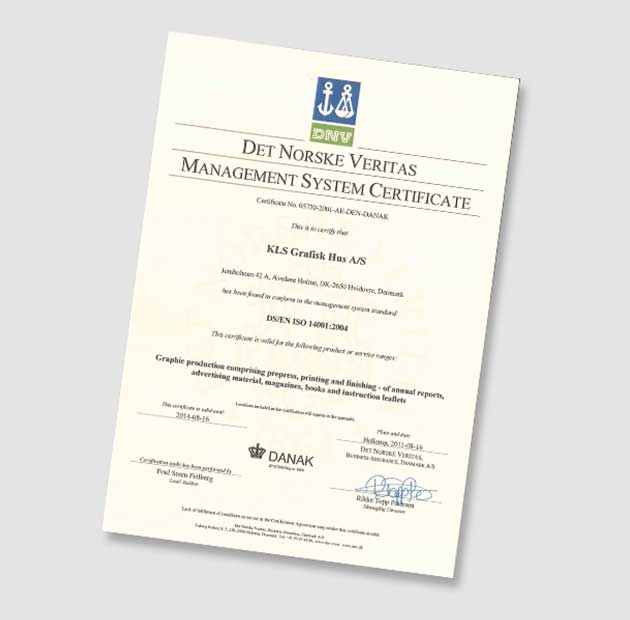
ECOLABELS: EVIDENCE AND COMMITMENT
Since 1996, KLS PurePrint has worked hard to optimize all environmental aspects of our processes and production. That is a never ending process. Today the company is certified in accordance with all relevant ecolabels and environmental certifications. The certifications have enabled us to set objectives and to document the achievement of those objectives. It all started with the Swan label in 1997 and the environmental management certificate ISO 14001 in 1999. In 2008, the FSC® (Forest Stewardship Council) certification for sustainable forestry was added.
Cradle to Cradle – the ultimate certificate
Once the 100% biodegradable product PurePrint was developed, KLS PurePrint was certified in May 2015 in accordance with the world’s strictest environmental standard known as Cradle to Cradle.
THE NORDIC SWAN ECOLABEL
The Nordic Swan Ecolabel is a Nordic ecolabel for non-food products. The label was established by the Nordic Council of Ministers in 1989. Denmark joined in 1997. The Nordic Swan Ecolabel is used in all Nordic countries. Products with the label indicate that the product is among the least environmentally harmful in the product group in question.
The purpose of the label is to reduce the overall environmental impact from production and use. Therefore, the ecolabel looks at the entire journey of the product and at any environmental problems that arise along the way — for the benefit of people, the environment and Earth’s resources. The Nordic Swan Ecolabel is adapted to various lines of industry, so there may be differences in the requirements placed on different products.
The Nordic Swan Ecolabel is one Denmark’s official ecolabels and KLS PurePrint has held Nordic Swan Ecolabel certification since 1997.
FSC
The FSC is an international non-profit label scheme for wood and paper. In an FSC forest, trees are felled at a rate no faster than the forest can rejuvenate itself. At the same time, the FSC is a guarantee that animal and plant life are protected and that forest workers are trained and employed on fair terms. PurePrint paper and PurePrint board always come from FSC-certified forests and other responsible forests.
KLS PurePrint has been FSC-certified since 2008 and is a member of FSC Denmark.
View our certificates
ENVIRONMENTAL AWARDS
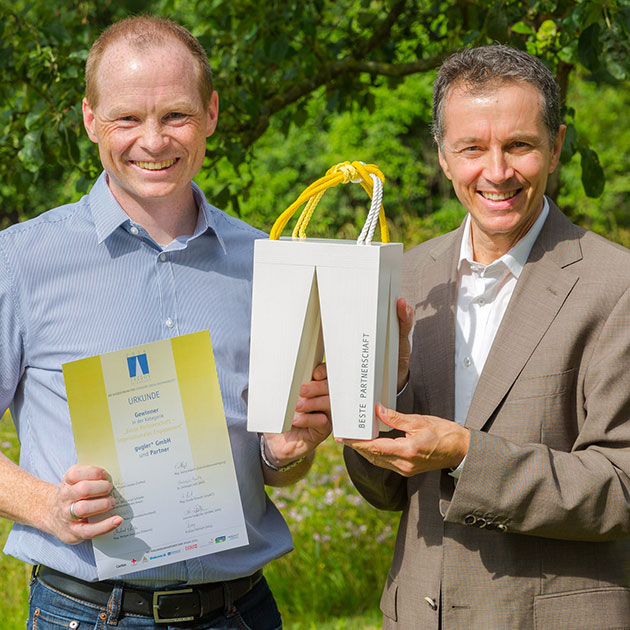
AWARDS FOR ENVIRONMENTAL EFFORTS
Over the years, KLS PurePrint has received numerous awards for its visionary work with environmental and climate protection. In 2001, the company received The Municipality of Hvidovre Environmental Award for setting the goal of becoming the world’s greenest printing house – and for establishing concrete plans to achieve that ambition.
In 2012, KLS PurePrint again received The Municipality of Hvidovre Environmental Award for having come a long way in its environmental and climate related efforts and for having started the PurePrint production of 100% biodegradable printed matter completely free of harmful chemicals and heavy metals.
In 2008, KLS PurePrint was awarded the Climate Cup Strategy Award for being Denmark’s first CO2 neutral printing house.
According to the judging panel’s rationale, KLS PurePrint earned the awards because the company shows clear leadership within its sector and strives to influence customers and business partners to take a stand on climate change.
In 2016, KLS PurePrint was named Enterprise of the Year in the Municipality of Hvidovre for having made PurePrint a reality and then launching it in 2015.
In August 2016 KLS PurePrint is winning the prestigious CSR Award TRIGOS, together with the Austrian printing GUGLER *. The price is awarded for their joint work with sustainable Cradle to Cradle certified printed products.
In 2019, KLS PurePrint was awarded the 2019 Food Innovation Award for the development of sustainable packaging. The award is given in recognition of the efforts of companies that have a sustainable footprint in Denmark.
THE UN’S SUSTAINABLE DEVELOPMENT GOALS
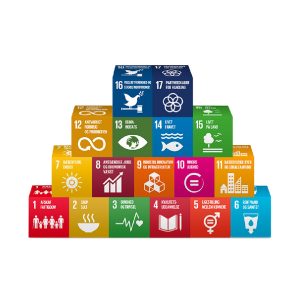
At KLS PurePrint, we have worked for many years to improve the environment through environmentally friendly actions and to develop printed matters and packaging that are as environmentally sound and sustainable as humanly possible. The work is an element in our vision of becoming the world’s most sustainable printing company.
We had already implemented many actions that were fully in line with the UN’s Sustainable Development Goals, which is why we decided to work purposefully with the UN’s Sustainable Development Goals. KLS PurePrint attained Cradle to Cradle certification on 4 May 2015 — and the UN’s Sustainable Development Goals were launched on 16 September 2015.
Quite specifically, we work with the seven goals that hold the most relevance to us
Three of the goals are important for the products we manufacture and therefore also for our clients’ sustainability work.
The first one is Goal no. 3 — GOOD HEALTH AND WELL-BEING. In order to comply with the requirements of the Cradle to Cradle certification at min. Bronze level it must be ensured that the packaging is free of any hazardous chemicals listed in the “Banned List of Chemicals”. Compared with all the rest of our sustainable initiatives, this means that our clients can put printed matters and packaging on the market with a clear conscience.
The second one is Goal no. 12 — RESPONSIBLE CONSUMPTION AND PRODUCTION. Cradle to Cradle is the epitome of circular economy, which is one of the most important parts of Goal no. 12.
The first one is Goal no. 15 — LIFE ON LAND. This goal has to do, among other things, with sustainable forest management. Thus, PurePrint paper and board are FSC certified, which guarantees that the timber comes from sustainable forestry.
The last four goals are essential for the company’s work to promote sustainable development.
Goal no. 6 — CLEAN WATER AND SANITATION. Securing water resources is one of the five focus areas in a Cradle to Cradle certification. We have replaced, among other things, our water purification plant, so the water that is discharged from the factory is cleaner than the water that is pumped in.
Goal no. 7 — AFFORDABLE AND CLEAN ENERGY. KLS PurePrint has had a focus on energy for more than 10 years. We invested in a wind turbine in 2009, purchased Denmark’s first electric lorry in 2010 and have only purchased electric company cars since 2011. We have been carbon-neutral (carbon offset — see here) since 2009.
Goal no. 13 CLIMATE ACTION. KLS PurePrint has been working actively with environmental improvements since 1997. Climate action has been the number one priority in our work for several years. Investing in a wind turbine, driving electric company cars and working to become carbon neutral constitute important elements in this work.
Goal no. 17 — PARTNERSHIPS FOR THE GOALS. The preparation of sustainable brochures and packaging has only been made possible through extensive cooperation along the entire value chain. An important element here is our cooperation with the two other Cradle to Cradle certified printing houses in the world. In 2016, we received the prestigious CSR TRIGOS award.
KLS PurePrint has developed various products that can be used in the work with the UN’s 17 Sustainable Development Goals.
GLOBAL COMPACT
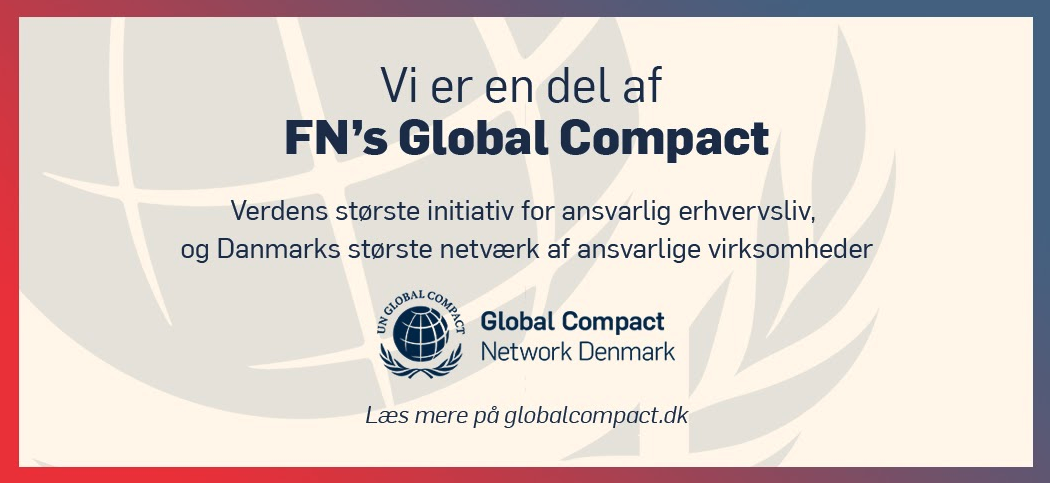
We are a member of the United Nations Global Compact and are part of the UN’s Global Compact and Global Compact Network Denmark. This is the world’s largest corporate social responsibility initiative and Denmark’s largest network for responsible companies, respectively. Through our membership, we work with the Global Compact’s 10 principles within the areas of human rights, labour rights, the environment and anti-corruption as well as with the 17 Sustainable Development Goals.
Read more about Global Compact Network Denmark on www.globalcompact.dk
INSPIRATIONAL TEXTS
Inspirational texts for products produced by KLS PurePrint
We see an immense interest among our customers in describing the environmental choices they have made by opting for PurePrint for their printed matters or packaging. As a guide, we have prepared the following wording for the environmental and sustainability certifications we at KLS PurePrint are able to offer.
The texts can be used in their entirety or in part, as desired by each client.
Note that there can be material choices, or combinations of material choices, that will make it impossible to use all 4 ecolabels, even though they are displayed in the text below. You must therefore make sure that your printed matter or packaging lives up to the environmental and sustainability certifications you would like to use.
Your offer or order confirmation will indicate which wording and which ecolabels you will be able use. Nevertheless, you are always welcome to contact your contact person at KLS PurePrint and request a clarification and a specification of the exact requirements for the use of the logo of each individual ecolabel.
Packaging where all materials are approved in accordance with Cradle to Cradle
This packaging is produced subject to the highest environmental standards possible, for the benefit of both people and nature.
The product is Cradle to Cradle-certified, which is your guarantee that the paper and printing inks are produced without chemicals and heavy metals registered in the Banned List of Chemicals. The Cradle to Cradle certification is one of the world’s strictest environmental certifications, which guarantees that a product neither pollutes, nor uses Earth’s limited resources, but is part of nature’s cycle of life. It also ensures that the printed products are produced under as environmentally-friendly conditions as possible.
The packaging also bears the Nordic Swan label, the official ecolabel for the entire Nordic region. The label makes it easy to choose among the products and services that are best for the environment.
The packaging is carbon neutral, the factory only uses local wind power, documented with certificates of origin and the packaging is compostable according to EN 13432.
The pulp for the cardboard comes from sustainable FSC forestry in Europe. This means that the origin of the pulp is certified, while simultaneously ensuring that only as many trees are felled as can be replenished by the forest.
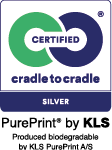
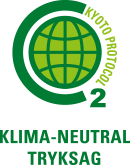

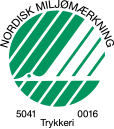
Packaging where not all materials are approved in accordance with Cradle to Cradle
This packaging is produced subject to the highest environmental standards possible, for the benefit of both people and nature.
The packaging is printed on Cradle to Cradle-certified cardboard and with Cradle to Cradle-certified printing inks — both of which are produced without chemicals and heavy metals registered in the Banned List of Chemicals. The Cradle to Cradle certification is one of the world’s strictest environmental certifications, which guarantees that a product neither pollutes, nor uses Earth’s limited resources, but is part of nature’s cycle of life. It also ensures that the printed products are produced under as environmentally-friendly conditions as possible.
The packaging also bears the Nordic Swan label, the official ecolabel for the entire Nordic region. The label makes it easy to choose among the products and services that are best for the environment.
The packaging is carbon neutral, the factory only uses local wind power, documented with certificates of origin and the packaging is compostable according to EN 13432.
The pulp for the cardboard comes from sustainable FSC forestry in Europe. This means that the origin of the pulp is certified, while simultaneously ensuring that only as many trees are felled as can be replenished by the forest.
We recommend that in continuation of the Cradle to Cradle description, you also describe which specific materials you have used that are not yet Cradle to Cradle-certified, e.g. UV varnish, Pantone colours and hot foil.



Printed matter where all materials are approved in accordance with Cradle to Cradle
For example, stapled printed matters, brochures, leaflets, flyers, posters.
This brochure is produced in accordance with the highest environmental standards possible, for the benefit of both people and nature.
The product is Cradle to Cradle-certified, which is your guarantee that the paper and printing inks are produced without chemicals and heavy metals registered in the Banned List of Chemicals. The Cradle to Cradle certification is one of the world’s strictest environmental certifications, which guarantees that a product neither pollutes, nor uses Earth’s limited resources, but is part of nature’s cycle of life. It also ensures that the printed products are produced under as environmentally-friendly conditions as possible.
The brochure also bears the Nordic Swan label, the official ecolabel for the entire Nordic region. The label makes it easy to choose among the products and services that are best for the environment.
The brochure is carbon neutral and the factory uses only local wind power documented via certificates of origin.
The pulp for the paper comes from sustainable FSC forestry in Europe. This means that the origin of the pulp is certified, while simultaneously ensuring that only as many trees are felled as can be replenished by the forest.




Printed matter where not all materials are approved in accordance with Cradle to Cradle
For example, FlexBind and hardcover books.
This book is produced in accordance with the highest environmental standards possible, for the benefit of both people and nature.
The book is printed on Cradle to Cradle-certified paper and with Cradle to Cradle-certified printing inks — both of which are produced without chemicals and heavy metals registered in the Banned List of Chemicals. The Cradle to Cradle certification is one of the world’s strictest environmental certifications, which guarantees that a product neither pollutes, nor uses Earth’s limited resources, but is part of nature’s cycle of life. It also ensures that the printed products are produced under as environmentally-friendly conditions as possible.
The book also bears the Nordic Swan label, the official ecolabel for the entire Nordic region. The label makes it easy to choose among the products and services that are best for the environment.
The book is carbon neutral and the factory uses only local wind power documented via certificates of origin.
The pulp for the paper comes from sustainable FSC forestry in Europe. This means that the origin of the pulp is certified, while simultaneously ensuring that only as many trees are felled as can be replenished by the forest.
We recommend that in continuation of the Cradle to Cradle description, you also describe which specific materials you have used that are not yet Cradle to Cradle-certified, e.g. FlexBind adhesives, lining and Pantone colours.



CAN WE HELP?
If you would like to know more about options, products, sustainability, Cradle to Cradle or something else, do not hesitate to give us a call or fill in the form, and we will get back to you promptly.

